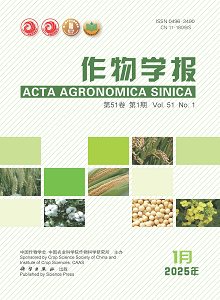玉米秸秆还田连作条件下氮素积累及氮素替代效应
引用次数: 0
摘要
:东北地区农作物秸秆资源丰富,但焚烧和丢弃现象严重,养分利用率很低。探讨了寒区连作条件下秸秆还肥替代氮肥的可行性及其对氮素积累的影响。2017 - 2019年,在东北农业大学试验点进行了15 N标记尿素的框架培养和连续定位试验。试验采用三因素分畦设计,主小区为秸秆还田法,其中秸秆不还田(S0)和秸秆还田(S1),次小区为施氮水平为0 (N0)、175 (N1)和350 (N2) kg hm -2。每个施肥量设置两种施用方式,一种施用基肥与追肥的比例为1:1,另一种施用基肥与追肥的比例为1:0。结果表明:秸秆还田量为12 t hm -2时,还田秸秆可替代纯氮36.8 kg hm -2;2017 - 2019年,黑龙江省平均玉米秸秆用量为4650万吨,秸秆还田可替代纯氮14.27万吨。基肥与追肥比例为1:1时的纯氮替代量比1:0时提高了26.88%。秸秆还田与玉米氮素利用效率呈负相关。尿素用量为350 kg hm -2(纯氮用量为161 kg hm -2)时,S0处理玉米氮素平均利用率比S1处理高6.09%,S1处理产量比S1处理高4.66%。秸秆还田追肥处理玉米产量最高,为268.22 g - frame -1。综上所述,东北地区玉米秸秆还田过程中氮素替代效应显著。作物秸秆与氮肥长期配施显著提高了玉米生物量、产量和氮素积累量,是东北地区玉米增产增效的栽培模式。本文章由计算机程序翻译,如有差异,请以英文原文为准。
Nitrogen accumulation and nitrogen substitution effect of maize under straw returning with continuous cropping
: Crop straw resources in Northeast China are rich, but burning and discarding are serious, and nutrient utilization rate is very low. We explored the feasibility of the substitution of straw returning to nitrogen fertilizer and its effects on nitrogen accumulation under continuous cropping in cold region. A frame culture and continuous positioning experiment was carried out in the experimental site of Northeast Agricultural University from 2017 to 2019, with 15 N labeled urea. A three-factor split-plot design was adopted in this experiment, the main plot was straw returning method with no straw returning (S0) and straw returning (S1), and the sub-plot was nitrogen application levels with 0 (N0), 175 (N1), and 350 (N2) kg hm –2 . Two application methods were set for each fertilizer application amount, one ratio of base fertilizer and top dressing applied was 1:1, and the other ratio of base fertilizer and top dressing applied was 1:0. The results were as follows: When the straw returning amount was 12 t hm –2 , the returning straw could replace 36.8 kg hm –2 pure nitrogen. The average amount of maize straw was 46.50 million tons in Heilongjiang Province from 2017 to 2019, and straw returning could replace 142,700 tons pure nitrogen. The replace amount of pure nitrogen in the ratio of base fertilizer and top dressing (1:1) was 26.88% higher than that in 1:0. Straw returning was negatively correlated with nitrogen use efficiency in maize. The average nitrogen use efficiency of maize in S0 treatment was 6.09% higher than S1 treatment, and the yield of S1 treatment was 4.66% higher than S0 treatment when the urea application amount was 350 kg hm –2 (161 kg hm –2 pure nitrogen). The highest yield of maize was 268.22 g frame –1 in the treatment of straw returning and topdressing with commonly fertilizer applied in local agriculture. In conclusion, the nitrogen substitution effect was remarkable under maize straw returning in Northeast China. Long-term combined application of crop straw and nitrogen fertilizer significantly improved the biomass, yield, and nitrogen accumulation of maize, which was a cultivation mode for increasing yield and efficiency of maize in Northeast China.
求助全文
通过发布文献求助,成功后即可免费获取论文全文。
去求助
来源期刊

作物学报
Agricultural and Biological Sciences-Agronomy and Crop Science
CiteScore
1.70
自引率
0.00%
发文量
89
期刊介绍:
The major aims of AAS are to report the progresses in the disciplines of crop breeding, crop genetics, crop cultivation, crop physiology, ecology, biochemistry, germplasm resources, grain chemistry, grain storage and processing, bio-technology and biomathematics etc. mainly in China and abroad. AAS provides regular columns for Original papers, Reviews, and Research notes. The strict peer-review procedure guarantees the academic level and raises the reputation of the journal. The readership of AAS is for crop science researchers, students of agricultural colleges and universities, and persons with similar academic level.
 求助内容:
求助内容: 应助结果提醒方式:
应助结果提醒方式:


